Thursday, 29 November 2012: Auckland: Arataki visitors' center and the downtown museum
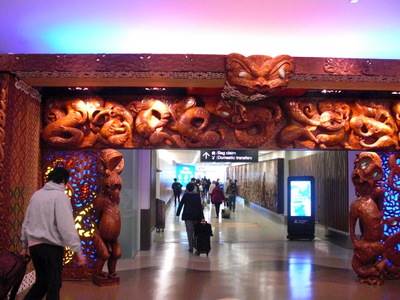
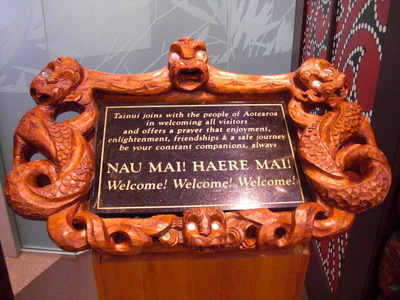 You'll notice the absence of a 28 November entry. We lost that day entirely, in transit, because of the date line—we left Los Angeles on 27 November, few for 11 or 12 hours, and arrived at breakfast time in Auckland on 29 November.
arrivals at the airport passed through this Maori portal after baggage claim. The large iridescent eyes of the larger creatures are paua (abalone) shells.
You'll notice the absence of a 28 November entry. We lost that day entirely, in transit, because of the date line—we left Los Angeles on 27 November, few for 11 or 12 hours, and arrived at breakfast time in Auckland on 29 November.
arrivals at the airport passed through this Maori portal after baggage claim. The large iridescent eyes of the larger creatures are paua (abalone) shells.
I thought the USDA was twitchy about allowing foodstuffs into the states, but in New Zealand, they're really paranoid. Had we visited a forest recently (how should a Tallahassee resident answer that?!); were we bringing in any sports equipment, like golf shoes, that might have dirt on it; did we have any plants, animals, or seeds with us; and above all, were we carrying any food of any kind whatever? (no, we had been forewarned). Food-sniffing dogs were on duty We never did figure out what typically north-Florida item we could bring as a visiting gift—clearly not smoked mullet, tupelo honey, lemons from our tree, boiled peanuts (even in a can), or (heaven forefend!) something home baked. So we just planned to take our hosts out to dinner somewhere nice.
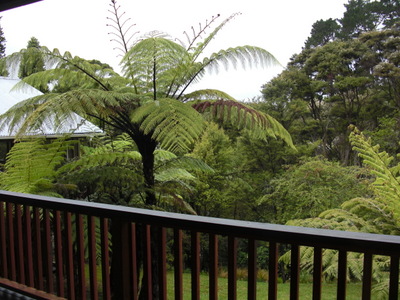
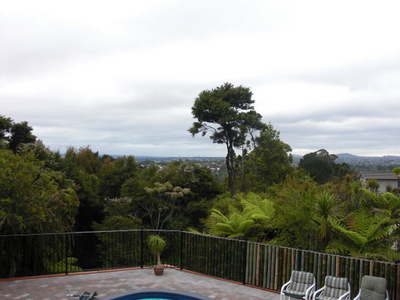 Our hosts were David's former postdoctoral associate Kay (rhymes with sky) Vopel, his wife Angie, and their two children Luke and Leah (yes, really). Luke is 9 and Leah 8. They live on the boundary between northwest Auckland suburbs Green Bay and Kitirangi, just at the edge of the heavily forested Waitakere mountain ranges. Their house is on the crest of a steep slope, and their main living space is on the top floor, so it's like living in a tree house. This tree fern is in their back yard and was photographed from the deck off the back of the lower floor. The back deck of the upper floor looks down on it.
Our hosts were David's former postdoctoral associate Kay (rhymes with sky) Vopel, his wife Angie, and their two children Luke and Leah (yes, really). Luke is 9 and Leah 8. They live on the boundary between northwest Auckland suburbs Green Bay and Kitirangi, just at the edge of the heavily forested Waitakere mountain ranges. Their house is on the crest of a steep slope, and their main living space is on the top floor, so it's like living in a tree house. This tree fern is in their back yard and was photographed from the deck off the back of the lower floor. The back deck of the upper floor looks down on it.
The other photo is of part of the panoramic view back over the city of Auckland from their upper front deck. The cluster of tall buildings marking North Auckland is hidden behind the tall trees.
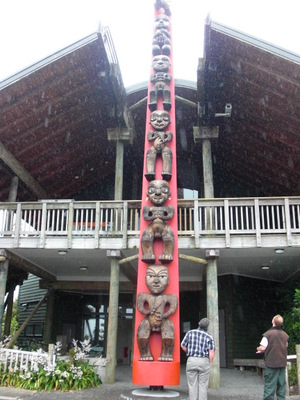
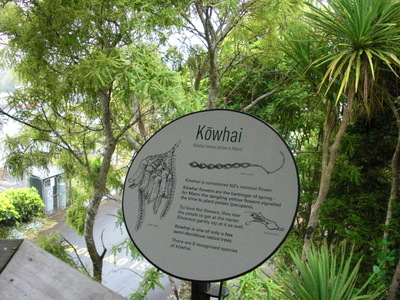 As soon as we had unpacked, had a cup of tea, and been introduced to Stella, the family's six-year-old pet sulfur-crested cockatoo (the plan was originally to acquire a second, named Artois, but that didn't happen), Kay drove us off the to Arataki visitors' center, one of the gateways to the large Waitakere reserve. You enter the center through this magnificant porch. Inside, we saw terraria and aquaria displaying live wetas (large cricket-like insects much beloved of the New Zealanders), geckos (which looked more like the eastern fence swifts of my childhood than like geckos), and local fishes.
As soon as we had unpacked, had a cup of tea, and been introduced to Stella, the family's six-year-old pet sulfur-crested cockatoo (the plan was originally to acquire a second, named Artois, but that didn't happen), Kay drove us off the to Arataki visitors' center, one of the gateways to the large Waitakere reserve. You enter the center through this magnificant porch. Inside, we saw terraria and aquaria displaying live wetas (large cricket-like insects much beloved of the New Zealanders), geckos (which looked more like the eastern fence swifts of my childhood than like geckos), and local fishes.
Around the visitors' center are elevated boardwalks from which one can view carefully labeled specimens of local trees. That was where I learned that the legendary kauri (Agathis australis) is in the Araucariaceae. I had long known that the Norfolk Island pine ("monkey puzzle tree") was one of only two members of the genus Araucaria (both of which I've often seen), but I had not realized that the only genus in that family is Agathis. We could have taken any of a variety of short nature walks, but it was raining, so we skipped that part.
After a lunch of wraps and paninis at the Hardware Café in nearby Titirangi (the most popular filling for any sandwich in New Zealand seems to be bacon and egg; that's British-style bacon, more like ham), we drove downtown to the Auckland War Memorial museum, where we were just in time for a Maori cultural show with dancers and singers. I got some photos, but the lighting was very red and dim, so they don't display well on line, and many were blurred by movement.
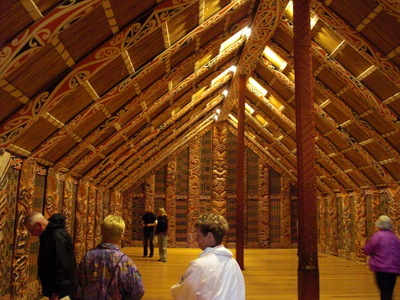
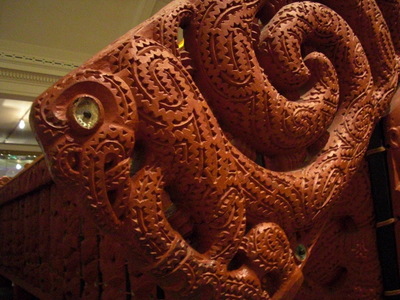 The museum has a particularly large and fine collection of Maori articles. We were asked to remove our shoes before entering this carved and painted ceremonial house. At the right is a detail of the carving on another building, displayed nearby. I was especially taken with the variety of bird and fish traps devised by the Maori, all made of wood and/or New Zealand "flax" (Phormium tenax, Xanthorrhoeaceae), an extremely common plant whose leaves yielded fiber and a sort of rattan for weaving. Some traps were perching sticks with attached cords that a waiting hunter could pull to pin the birds' feet to the perch. Others were wooden troughs of water placed high in treetrops and festooned with many thin little fiber nooses. To drink, a thirsty bird would put its head through an open noose, which tightened when the bird tried to fly away. The display even specified that the Maori captured large numbers of birds in season, then cooked and stored them in their own fat for use later—in other words, they made "confit," just as the French do with ducks and geese (and sometimes pork)!
The museum has a particularly large and fine collection of Maori articles. We were asked to remove our shoes before entering this carved and painted ceremonial house. At the right is a detail of the carving on another building, displayed nearby. I was especially taken with the variety of bird and fish traps devised by the Maori, all made of wood and/or New Zealand "flax" (Phormium tenax, Xanthorrhoeaceae), an extremely common plant whose leaves yielded fiber and a sort of rattan for weaving. Some traps were perching sticks with attached cords that a waiting hunter could pull to pin the birds' feet to the perch. Others were wooden troughs of water placed high in treetrops and festooned with many thin little fiber nooses. To drink, a thirsty bird would put its head through an open noose, which tightened when the bird tried to fly away. The display even specified that the Maori captured large numbers of birds in season, then cooked and stored them in their own fat for use later—in other words, they made "confit," just as the French do with ducks and geese (and sometimes pork)!
Perhaps the most spectacular display (unfortunately impossible to photograph) was of a giant ceremonial and war canoe carved from a single tree trunk. It was 25 meters (!) long, was adorned with tall, an elaborately carved figure head (and tail), and could carry 100 warriors!
At this point, we were reeling, and our brains and stomachs had absolutely no idea what time of day it was, so Kay dropped us off at the house before going out to pick up the children from school. (They must be dropped off about 8:15 every morning and picked up at 3:00 p.m., so Kay and Angie alternate days. When Angie drops them at school, she works a normal work day, but Kay leaves the office early to pick them up, then works from home for the rest of the day. When Kay drops them off, Angie goes to work at the crack of dawn so as to get in a full work day before picking them up, while Kay stays at the office for the full day, so they avoid paying for daycare. Slick.)
Kay is a serious griller, so he fired up the gas grill and grilled chicken, bacon, and pineapple kabobs for dinner. Later, after the children were sent off to bed, Stella (whose cage spends the day outdoors on the upper front deck but is brought back in over night) was released from her cage and allowed the freedom of the large cathedral-ceilinged living room, where she wheeled overhead and flew from sofa to sofa, visiting each of us in turn (although she was a little too suspicious to let David or me pet her). She's trained not to soil the furniture but to fly back to her cage as needed.
previous entry
List of Entries
next entry

 You'll notice the absence of a 28 November entry. We lost that day entirely, in transit, because of the date line—we left Los Angeles on 27 November, few for 11 or 12 hours, and arrived at breakfast time in Auckland on 29 November.
arrivals at the airport passed through this Maori portal after baggage claim. The large iridescent eyes of the larger creatures are paua (abalone) shells.
You'll notice the absence of a 28 November entry. We lost that day entirely, in transit, because of the date line—we left Los Angeles on 27 November, few for 11 or 12 hours, and arrived at breakfast time in Auckland on 29 November.
arrivals at the airport passed through this Maori portal after baggage claim. The large iridescent eyes of the larger creatures are paua (abalone) shells.
 Our hosts were David's former postdoctoral associate Kay (rhymes with sky) Vopel, his wife Angie, and their two children Luke and Leah (yes, really). Luke is 9 and Leah 8. They live on the boundary between northwest Auckland suburbs Green Bay and Kitirangi, just at the edge of the heavily forested Waitakere mountain ranges. Their house is on the crest of a steep slope, and their main living space is on the top floor, so it's like living in a tree house. This tree fern is in their back yard and was photographed from the deck off the back of the lower floor. The back deck of the upper floor looks down on it.
Our hosts were David's former postdoctoral associate Kay (rhymes with sky) Vopel, his wife Angie, and their two children Luke and Leah (yes, really). Luke is 9 and Leah 8. They live on the boundary between northwest Auckland suburbs Green Bay and Kitirangi, just at the edge of the heavily forested Waitakere mountain ranges. Their house is on the crest of a steep slope, and their main living space is on the top floor, so it's like living in a tree house. This tree fern is in their back yard and was photographed from the deck off the back of the lower floor. The back deck of the upper floor looks down on it.
 As soon as we had unpacked, had a cup of tea, and been introduced to Stella, the family's six-year-old pet sulfur-crested cockatoo (the plan was originally to acquire a second, named Artois, but that didn't happen), Kay drove us off the to Arataki visitors' center, one of the gateways to the large Waitakere reserve. You enter the center through this magnificant porch. Inside, we saw terraria and aquaria displaying live wetas (large cricket-like insects much beloved of the New Zealanders), geckos (which looked more like the eastern fence swifts of my childhood than like geckos), and local fishes.
As soon as we had unpacked, had a cup of tea, and been introduced to Stella, the family's six-year-old pet sulfur-crested cockatoo (the plan was originally to acquire a second, named Artois, but that didn't happen), Kay drove us off the to Arataki visitors' center, one of the gateways to the large Waitakere reserve. You enter the center through this magnificant porch. Inside, we saw terraria and aquaria displaying live wetas (large cricket-like insects much beloved of the New Zealanders), geckos (which looked more like the eastern fence swifts of my childhood than like geckos), and local fishes. 
 The museum has a particularly large and fine collection of Maori articles. We were asked to remove our shoes before entering this carved and painted ceremonial house. At the right is a detail of the carving on another building, displayed nearby. I was especially taken with the variety of bird and fish traps devised by the Maori, all made of wood and/or New Zealand "flax" (Phormium tenax, Xanthorrhoeaceae), an extremely common plant whose leaves yielded fiber and a sort of rattan for weaving. Some traps were perching sticks with attached cords that a waiting hunter could pull to pin the birds' feet to the perch. Others were wooden troughs of water placed high in treetrops and festooned with many thin little fiber nooses. To drink, a thirsty bird would put its head through an open noose, which tightened when the bird tried to fly away. The display even specified that the Maori captured large numbers of birds in season, then cooked and stored them in their own fat for use later—in other words, they made "confit," just as the French do with ducks and geese (and sometimes pork)!
The museum has a particularly large and fine collection of Maori articles. We were asked to remove our shoes before entering this carved and painted ceremonial house. At the right is a detail of the carving on another building, displayed nearby. I was especially taken with the variety of bird and fish traps devised by the Maori, all made of wood and/or New Zealand "flax" (Phormium tenax, Xanthorrhoeaceae), an extremely common plant whose leaves yielded fiber and a sort of rattan for weaving. Some traps were perching sticks with attached cords that a waiting hunter could pull to pin the birds' feet to the perch. Others were wooden troughs of water placed high in treetrops and festooned with many thin little fiber nooses. To drink, a thirsty bird would put its head through an open noose, which tightened when the bird tried to fly away. The display even specified that the Maori captured large numbers of birds in season, then cooked and stored them in their own fat for use later—in other words, they made "confit," just as the French do with ducks and geese (and sometimes pork)!